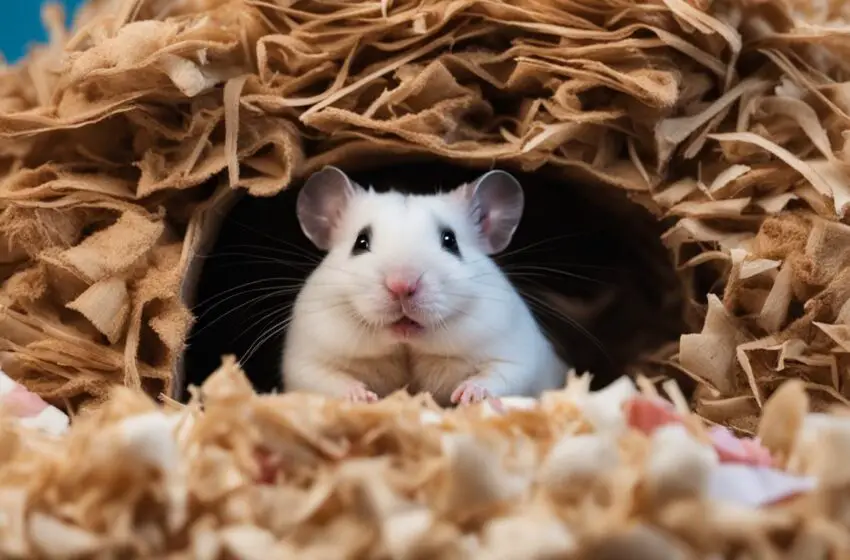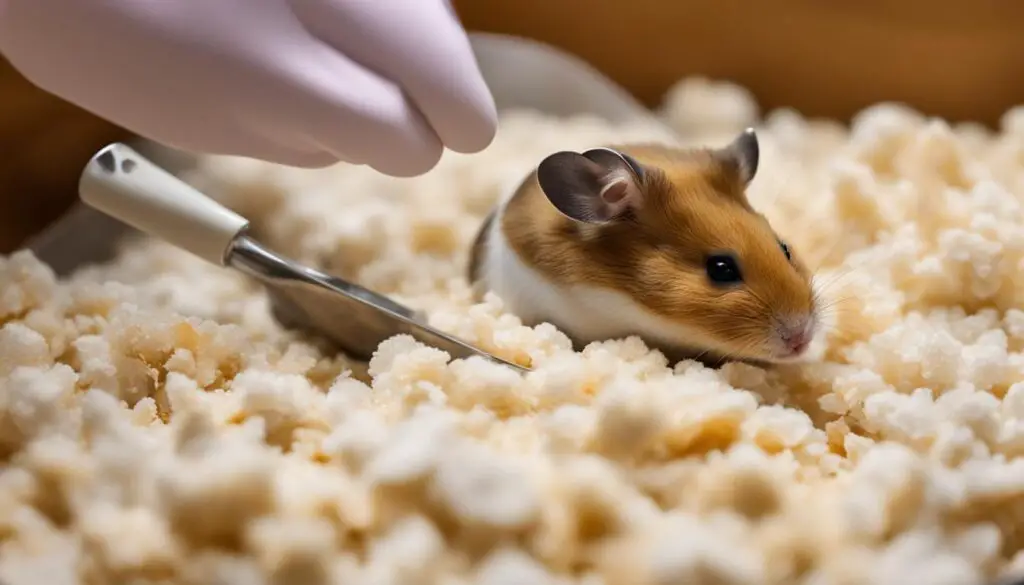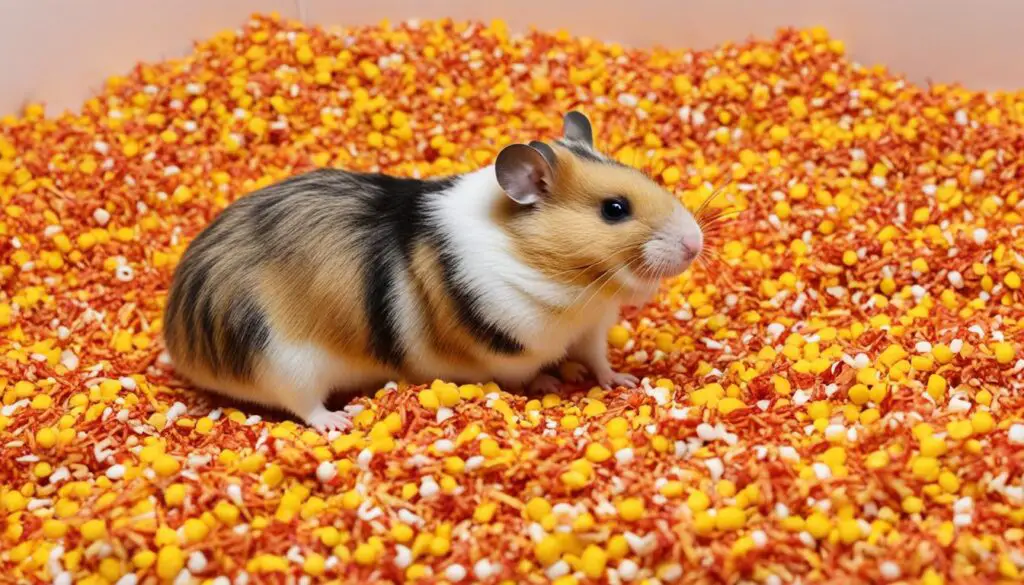Choosing the Best Bedding Options for Hamsters

When it comes to providing a comfortable and safe habitat for your pet hamster, choosing the right bedding is essential. The type of bedding you choose can impact your hamster’s health and overall well-being. There are several options available, each with its own pros and cons. To make an informed decision, it’s important to consider factors such as absorbency, odor control, dustiness, and suitability for burrowing.
When considering bedding options for your hamster, it’s important to choose a material that is absorbent enough to keep the cage dry and clean. Odor control is also a crucial factor in order to maintain a fresh-smelling environment. Dustiness should be minimized to prevent respiratory issues in both you and your pet. Lastly, ensuring that the bedding material allows for burrowing and tunneling will satisfy your hamster’s natural instincts.
Key Takeaways:
- Choosing the right bedding is crucial for your hamster’s comfort and health.
- Consider factors such as absorbency, odor control, dustiness, and suitability for burrowing.
- Popular bedding options include aspen shavings, paper-based bedding, and coconut fiber.
- Avoid cedar and pine shavings, as they can be harmful to your hamster’s respiratory system.
- Regular cleaning and maintenance of the bedding will ensure a healthy environment for your pet.
Factors to Consider When Choosing Hamster Bedding
Before selecting a bedding material for your hamster, there are a few important factors to consider:
- Burrowing and Tunneling: Hamsters are natural burrowers, so it’s crucial to choose bedding that allows them to engage in their instinctual behavior. Look for bedding materials that are soft and loose, such as aspen shavings or paper-based bedding, which enable your hamster to create tunnels and burrows for exploration and security.
- Absorbency: To maintain a clean and dry living environment for your hamster, opt for bedding that is highly absorbent. Materials like recycled paper or paper pulp are excellent choices as they readily absorb moisture and prevent the buildup of unpleasant odors.
- Odor Control: Hamster cages can become smelly if proper odor control measures aren’t taken. Consider bedding options that have natural odor-controlling properties, such as coconut fiber or bedding with added baking soda. These types of bedding can help neutralize odors and keep the cage smelling fresh for longer periods.
- Allergies and Respiratory Issues: It’s essential to consider any allergies or sensitivities that you or your pet may have. Some bedding materials, like cedar and pine shavings, can emit strong aromatic oils that may cause respiratory issues or allergies in hamsters. Opt for bedding options that are dust-free and hypoallergenic to ensure the well-being of your pet.
By carefully considering these factors, you can choose the most suitable bedding for your hamster’s needs, promoting their comfort and overall health.
Important Note:
“The welfare of the animal should always be prioritized when selecting bedding. Choose materials that have been specifically designed for hamsters and avoid hazardous substances.”
Popular Bedding Options for Hamsters
When it comes to choosing the right bedding for your hamster, there are several popular options to consider. Each option offers unique features and benefits that can enhance your hamster’s comfort and well-being. In this section, I will explore three popular bedding options: aspen shavings, paper-based bedding, and coconut fiber. Let’s take a closer look at each one.
Aspen Shavings
Aspen shavings are a widely used bedding option for hamsters. They are known for their soft texture, which provides a comfortable surface for your hamster to walk and burrow on. In addition to their softness, aspen shavings have excellent odor control properties, helping to keep your hamster’s enclosure smelling fresh. These shavings also have low levels of dust, reducing the risk of respiratory issues in your pet.
Paper-Based Bedding
Paper-based bedding, such as recycled paper or paper pulp, is another popular choice for hamster bedding. This type of bedding is highly absorbent, effectively wicking away moisture and maintaining a dry living environment for your hamster. Additionally, paper-based bedding is virtually dust-free, making it a suitable option for hamsters with respiratory sensitivities. The eco-friendly nature of paper-based bedding is also a bonus for environmentally conscious pet owners.
Coconut Fiber
Coconut fiber, also known as coconut coir, is a natural and sustainable bedding option for hamsters. It offers excellent odor control, ensuring that your hamster’s enclosure remains fresh and pleasant. Coconut fiber is safe for hamsters to chew on, providing a source of mental stimulation and promoting dental health. This bedding material is also biodegradable, making it an environmentally friendly choice.
Choosing the right bedding option for your hamster is important for their comfort and overall health. Consider the specific needs and preferences of your hamster when making your decision. Whether you opt for aspen shavings, paper-based bedding, or coconut fiber, ensure that the bedding provides a clean, dry, and comfortable environment for your furry friend.
Bedding to Avoid for Hamsters
When it comes to choosing bedding for your hamster, it’s important to be aware of certain types that should be avoided. Here are some precautions to keep in mind:
- Cedar and pine shavings: While these shavings may seem like a natural option, they can actually be harmful to your hamster’s respiratory system. Cedar and pine emit strong aromatic oils that can cause respiratory issues, such as allergies or even pneumonia.
- Bedding with harmful chemicals or dyes: It’s crucial to avoid using any bedding that contains potentially harmful chemicals or dyes. These substances can be ingested or inhaled by your pet and pose a health risk.
To ensure the well-being of your hamster, it’s best to opt for bedding materials that are safe and promote a healthy living environment.
Bedding Options to Avoid for Hamsters
| Bedding Material | Potential Risks |
|---|---|
| Cedar shavings | Release of aromatic oils harmful to hamster respiratory system |
| Pine shavings | Emits strong aromatic oils that can cause respiratory issues |
| Bedding with harmful chemicals or dyes | Potential ingestion or inhalation of harmful substances |
Tips for Bedding Maintenance
Proper maintenance of your hamster’s bedding is crucial to ensure a clean and hygienic living environment for your furry friend. By following these simple bedding maintenance tips, you can keep your hamster’s habitat fresh and healthy.
Regular Spot Cleaning:
Perform regular spot cleaning to remove any soiled or wet areas from the bedding. This helps prevent bacterial growth and unpleasant odors. Use a small scoop or a spoon to remove the soiled bedding and replace it with fresh bedding. Spot cleaning should be done at least once a day or as needed.
Complete Bedding Replacement:
Depending on the type of bedding you choose for your hamster, you may need to completely replace it every few weeks or so. This ensures that the bedding remains fresh and free from any buildup of waste or odor. Refer to the packaging or product instructions for specific guidance on when to replace the bedding.
Cage Cleaning:
In addition to maintaining the bedding, it’s important to clean the hamster’s cage on a regular basis. This includes wiping down the cage walls, removing any debris or leftover food, and sanitizing any accessories or toys. Cleaning the cage helps maintain overall cleanliness and promotes a healthier living environment for your hamster.
Tip: For an effective cage cleaning solution, mix equal parts water and white vinegar. Dip a soft cloth or sponge into the solution and use it to clean the cage. Rinse thoroughly with water afterward to remove any vinegar residue.
Expert Tip:
“Maintaining clean bedding is essential to keep your hamster healthy and happy. Regular spot cleaning and complete bedding replacement are key components of proper bedding maintenance. Additionally, don’t forget to clean the hamster’s cage to ensure a clean and hygienic environment.”
| Bedding Maintenance Tips | Benefits |
|---|---|
| Perform regular spot cleaning | Prevents bacterial growth and odors |
| Replace bedding every few weeks | Maintains freshness and cleanliness |
| Clean the hamster’s cage regularly | Promotes a healthier living environment |

Additional Considerations for Bedding Choices
In addition to the general factors discussed earlier, there are certain additional considerations to keep in mind when selecting bedding for your hamster, especially if you have special needs or specific situations to address.
Pregnant Hamsters and Baby Hamsters
If you have a pregnant hamster or hamsters with babies, it’s important to provide them with suitable nesting materials to ensure their comfort and security. Pregnant hamsters require a cozy and safe environment to give birth and care for their young.
To create the perfect nest for your pregnant hamster or baby hamsters, consider using nesting fluff or paper strips. These materials are soft and provide insulation, ensuring a warm and comfortable space for the mother and her little ones. Ensure that the nesting material is non-toxic and safe for the hamsters to avoid any potential harm or injury.
“It is crucial to provide pregnant hamsters and baby hamsters with specific nesting materials that cater to their unique needs.” – Hamster Expert
Consult with a Veterinarian
If your hamster has any specific health or behavioral issues, it’s always wise to consult with a veterinarian. They can provide valuable guidance and help you determine the most appropriate bedding choice for your pet. A veterinarian will consider your hamster’s individual needs and potential sensitivities to ensure that the bedding you choose supports their overall well-being.
Remember, each hamster is unique, and what works for one may not work for another. Seeking professional advice ensures that you make the best decision for your hamster’s specific needs and circumstances.
To summarize, if you have a pregnant hamster or hamsters with babies, use nesting materials such as nesting fluff or paper strips to create a cozy and secure environment. Consulting with a veterinarian is always a good idea if your hamster has any specific health or behavioral concerns.
Now, let’s move on to the next section to explore how bedding can provide enrichment for your hamster’s habitat.
| Consideration | Special Needs | Recommended Bedding |
|---|---|---|
| Pregnant Hamsters | Require a cozy and secure nesting material for birthing and caring for babies. | Nesting fluff or paper strips |
| Baby Hamsters | Need a soft and warm nesting material for comfort and protection. | Nesting fluff or paper strips |
| Hamsters with Specific Health or Behavioral Issues | May require bedding that accommodates their unique needs and potential sensitivities. | Consult with a veterinarian for specific recommendations |
Providing Enrichment with Bedding
Bedding can play a crucial role in providing enrichment for your hamster’s habitat. By incorporating additional materials and creating a stimulating environment, you can encourage natural behaviors and keep your hamster entertained and engaged.
One way to enhance the habitat is by adding tunnels, hides, and nesting areas to the bedding. Creating different levels and hiding spots will allow your hamster to explore, mimic their natural habitat, and exercise their natural instincts. These additions can provide mental stimulation and promote physical activity, keeping your hamster happy and healthy.
Another idea is to include small toys within the bedding. Toys such as mini chew toys or puzzle feeders can provide mental stimulation for your hamster. They will not only keep your hamster entertained but also promote problem-solving skills and encourage exploration.
“Enrichment activities can help prevent boredom and stimulate your hamster’s mind. It’s important to provide them with a variety of options to keep them mentally and physically stimulated.”
Furthermore, hiding treats within the bedding can be a great way to engage your hamster’s sense of smell and encourage them to forage. This activity not only provides mental stimulation but also helps satisfy their natural instinct to search for food. Be sure to use hamster-safe treats and monitor your hamster during foraging activities.
Remember to regularly assess and refresh the enrichment materials in your hamster’s habitat. This will ensure continued engagement and prevent boredom. Rotating toys, rearranging hides and tunnels, and providing new challenges will keep your hamster interested and excited about their environment.

Conclusion
Choosing the right bedding for your hamster is crucial for their comfort, health, and overall well-being. When making your decision, consider factors such as absorbency, odor control, dustiness, and suitability for burrowing. Some popular options include aspen shavings, paper-based bedding, and coconut fiber. These materials provide a soft and safe environment for your hamster to burrow and nest, while also effectively controlling odors.
Avoid using bedding materials that can be harmful to hamsters, such as cedar and pine shavings. These types of bedding can release strong aromatic oils that may impact your hamster’s respiratory system. Instead, opt for bedding options that are safe and non-toxic.
Maintaining cleanliness and regular maintenance of the bedding is essential to ensure a fresh and healthy living environment for your hamster. Spot cleaning soiled areas regularly and replacing the bedding every few weeks will help prevent bacterial growth and keep odors at bay.
Additionally, consider any special needs or considerations your hamster may have. For pregnant hamsters or hamsters with babies, provide nesting materials such as paper strips or nesting fluff to create a secure and comfortable space. And remember, bedding can also serve as an opportunity for enrichment. By adding tunnels, hides, and toys to the bedding, you can create a stimulating habitat that encourages natural behaviors in your furry friend.
FAQ
What factors should I consider when choosing bedding for my hamster?
When choosing bedding for your hamster, consider factors such as absorbency, odor control, dustiness, and suitability for burrowing.
What are some popular bedding options for hamsters?
Some popular bedding options for hamsters include aspen shavings, paper-based bedding, and coconut fiber.
Are there any types of bedding that I should avoid using for my hamster?
Yes, you should avoid using cedar and pine shavings as bedding for your hamster as they can emit harmful aromatic oils that can cause respiratory issues.
How should I maintain my hamster’s bedding?
Regular spot cleaning should be done to remove any soiled or wet areas from the bedding. Depending on the type of bedding, you may also need to completely replace it every few weeks. It is also recommended to clean the hamster’s cage on a regular basis.
Are there any additional considerations for choosing bedding for my hamster?
If your hamster is pregnant or has babies, you may need to provide special nesting materials for them. Additionally, if your hamster has any specific health or behavioral issues, consult with a veterinarian to determine the most appropriate bedding choice.
Can bedding be used to provide enrichment for my hamster?
Yes, by providing additional materials such as tunnels, hides, and nesting areas, you can create a stimulating environment for your hamster. Adding small toys or hiding treats within the bedding can also provide mental stimulation.



